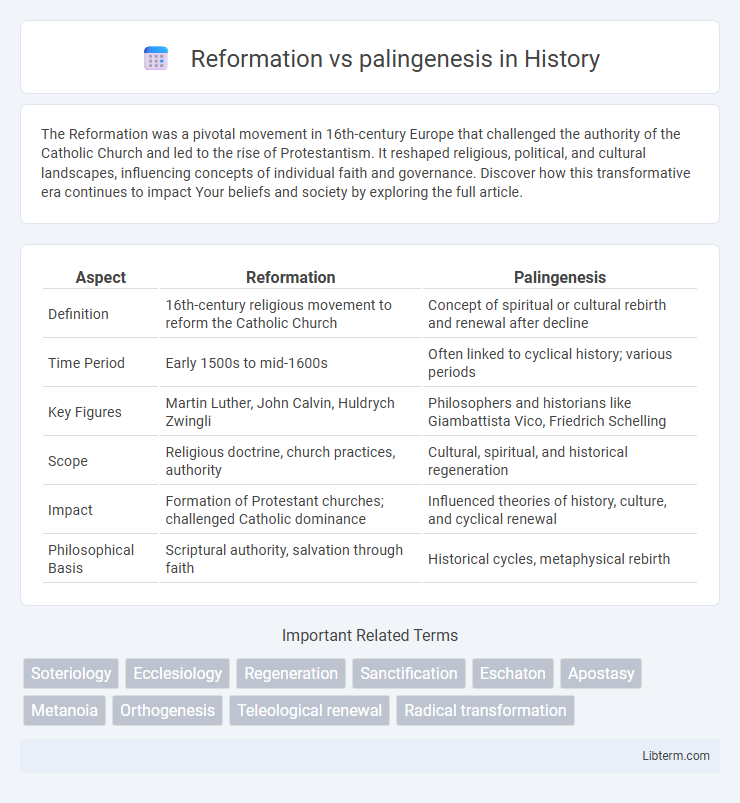The Reformation was a pivotal movement in 16th-century Europe that challenged the authority of the Catholic Church and led to the rise of Protestantism. It reshaped religious, political, and cultural landscapes, influencing concepts of individual faith and governance. Discover how this transformative era continues to impact Your beliefs and society by exploring the full article.
Table of Comparison
| Aspect | Reformation | Palingenesis |
|---|---|---|
| Definition | 16th-century religious movement to reform the Catholic Church | Concept of spiritual or cultural rebirth and renewal after decline |
| Time Period | Early 1500s to mid-1600s | Often linked to cyclical history; various periods |
| Key Figures | Martin Luther, John Calvin, Huldrych Zwingli | Philosophers and historians like Giambattista Vico, Friedrich Schelling |
| Scope | Religious doctrine, church practices, authority | Cultural, spiritual, and historical regeneration |
| Impact | Formation of Protestant churches; challenged Catholic dominance | Influenced theories of history, culture, and cyclical renewal |
| Philosophical Basis | Scriptural authority, salvation through faith | Historical cycles, metaphysical rebirth |
Introduction to Reformation and Palingenesis
Reformation refers to the process of making changes to improve or correct existing structures, often in religious, political, or social contexts, emphasizing transformation within an established framework. Palingenesis, on the other hand, denotes a concept of rebirth or regeneration, frequently associated with philosophies or movements advocating for a complete renewal or cyclical rebirth of systems or ideas. Understanding the distinctions between Reformation and Palingenesis highlights different approaches to change--incremental improvement versus profound renewal--each shaping historical and cultural developments uniquely.
Definitions: Reformation Explained
Reformation refers to the process of making significant improvements or changes within an existing structure, system, or institution, often aiming to correct faults or enhance functionality without entirely replacing the original framework. In contrast, palingenesis denotes a complete rebirth or regeneration, implying the creation of a new system or entity from the old one, often with profound transformation. Understanding reformation involves recognizing its focus on gradual evolution and amendment rather than total renewal.
Understanding Palingenesis
Palingenesis refers to the concept of rebirth or regeneration, often described as a cyclical process of renewal within philosophical, religious, or biological contexts. It contrasts with reformation, which typically implies transformation or improvement within an existing framework rather than complete renewal. Understanding palingenesis involves recognizing its role in spiritual traditions such as Gnosticism and Neoplatonism, where it symbolizes the soul's rebirth and transcendence beyond material limitations.
Historical Origins of Reformation
The Reformation originated in the early 16th century, sparked by Martin Luther's Ninety-Five Theses in 1517, challenging the Catholic Church's practices and doctrines. This movement emphasized doctrinal reform, biblical authority, and salvation through faith alone, reshaping European religious and political landscapes. Unlike palingenesis, which denotes spiritual rebirth or cyclical renewal, the Reformation specifically sought structural and theological change within Christianity's historical context.
Philosophical Roots of Palingenesis
Palingenesis, rooted in ancient philosophical traditions, especially Stoicism and Neoplatonism, emphasizes cyclical renewal and eternal return, contrasting with the Reformation's linear, historical approach to religious and social change. The concept of palingenesis draws from the idea that the cosmos and human soul undergo perpetual rebirth, aligning with metaphysical doctrines of cyclical time and spiritual regeneration. This philosophical foundation shapes its interpretation, promoting continuous transformation rather than a single, definitive reformation event.
Key Differences: Reformation vs Palingenesis
Reformation emphasizes gradual improvement and correction within existing structures, aiming to restore established norms and beliefs, whereas palingenesis represents a radical rebirth or complete renewal, often implying a profound transformation from previous conditions. Reformation is typically linked to modifying or reforming religious, political, or social institutions without overthrowing the foundational system, while palingenesis suggests the emergence of an entirely new order or era following a metaphorical or literal death and rebirth. The key difference lies in the scope and depth of change: reformation works within continuity, whereas palingenesis marks a fundamental discontinuity and renewal.
Societal Impact of Reformation
The Reformation profoundly reshaped European society by promoting literacy, education, and individualism through widespread access to religious texts, especially the Bible in vernacular languages. This movement challenged the centralized authority of the Catholic Church, leading to political decentralization and increased secular power in emerging nation-states. The societal impact of the Reformation also sparked significant religious conflicts, fostering diversity in Christian denominations and contributing to the development of modern pluralistic societies.
Palingenesis in Modern Thought
Palingenesis in modern thought represents the concept of spiritual or cultural rebirth, emphasizing cyclical renewal rather than linear reform. It contrasts with Reformation's focus on correction and improvement within existing frameworks by advocating for profound regeneration and transformative beginnings. Philosophers and theologians link palingenesis to the revival of classical ideas, suggesting a perpetual return to origins to achieve progress.
Reformation and Palingenesis in Practice
Reformation emphasizes gradual transformation by correcting existing structures, promoting renewal through improved laws, education, and social policies. Palingenesis in practice involves radical rebirth or complete regeneration, often manifesting as revolutionary movements that seek to discard previous systems entirely. In societal terms, reformation aims for continuous improvement, while palingenesis reflects abrupt, fundamental change to achieve a new beginning.
Conclusion: Choosing Between Reformation and Palingenesis
Choosing between reformation and palingenesis hinges on the desired scope and depth of transformation within a system or society. Reformation emphasizes gradual, structured improvement by modifying existing frameworks, preserving continuity and stability, whereas palingenesis advocates for a radical rebirth or complete renewal, often involving the creation of entirely new paradigms. The optimal approach depends on the context, urgency, and willingness to disrupt traditional structures to achieve long-term progress.
Reformation Infographic

 libterm.com
libterm.com